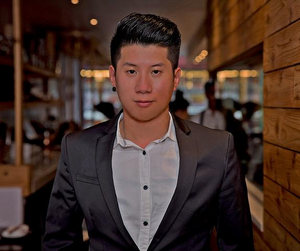Chef Spotlight: Executive Chef, Jay Zheng of KOYO in Astoria, Queens
Executive Chef, Jay Zheng of KOYO

Jay Zheng comes from a family of Chinese immigrants that fulfilled their American Dream by opening eight successful restaurants across the country. Zheng learned the ins-and-outs of the restaurant industry by traveling the country with his father to scout locations for new restaurant concepts and build each from the kitchen up.
After the 2008 financial crisis, Zheng decided to challenge himself and entered the hotel hospitality industry and went to work at the Peninsula Hotel in Chicago. There, he was exposed to the world of fine dining and found inspiration for his future pursuits. Zheng opened his first Japanese restaurant in 2012 in Indiana where he immersed himself in Japanese culture and learned how to source the best fish.
In 2016, Zheng left Chicago to return to his hometown, New York, to pursue his dream of working in fine dining and opened Gaijin with Chef Mark Garcia (now of Kissaki Sushi).
After parting ways with Chef Garcia, Zheng launched the first iteration of Kōyō in the same location in 2019. After the pandemic hit and restaurants were shut down, Zheng decided to, finally, step into the spotlight and begin his work as Kōyō's Executive Chef, re-launching the restaurant in a new direction and focusing on a kaiseki tasting menu.
Broadwayworld had the pleasure of interviewing Jay Zheng for our "Chef Spotlight."
What was your earliest interest in cooking?
I have spent just about my entire life in the restaurant business. As my father was a Chef/Restauranteur, he was the one who started me in this business. I started out helping around the kitchen when I was 11 for fun as everything seemed very intriguing to me. When I turned 13, my father let me pick up my first pan and learn how to cook, fry, stir fry, sear, braised, cut and so on.
Who were some of your career mentors?
I never had an official mentor that taught me everything, but I would say the biggest influence for me growing up in this restaurant industry was my father, Kai. It was tireless work throughout the years that gave me a chance to work with various experienced older chefs throughout his restaurants from Japanese, Chinese, Pan Asian to American cuisines. My father gave me a head start in the restaurant business and it helped me gained multiple years of experiences learning from all the older chef's that was working for him. When I left the family restaurant business, it was my turn to follow the footsteps of my father as a successful chef and restaurateur.
What culinary styles have influenced your career?
My family background is Chinese and the village we grew up on was a fishing village so fresh seafood played a huge role growing up. One of the ingredients that I loved eating growing up is Loofah Squash which is currently used in our omakase small dishes.
In 2010, I partnered up with my brother to open an Asian buffet restaurant focused on Sushi and Japanese cuisines called Kaizen. It was then where I started to have a better understanding of Japanese cuisines from older sushi chefs that was running the bar program.
What do you consider the most distinguishing features of your work as a chef?
There were very very few Kaiseki concepts in NYC and no one really still serves it the traditional way in a traditional setting. I believe to truly experience an Kaiseki cuisine in the current time is enjoy it at a Japanese ryokan. As being in NY, there is no such thing as ryokan in this concrete jungle so we have to adapt from the concept and add our modern approach. With the oversaturated market of sushi omakase in NY, I believe Kaiseki influence Omakase will be the next focus. I remember when I first opened Gaijin until now, there has been over 35 or more high end or low end omakase place that opened throughout NYC.
What is your favorite meal?
My favorite thing to eat is just simple steamed live crabs. Growing up in a fishing village, where money was a scarcity, just about every single housed raised some sort of livestock, grew vegetables or went fishing. Living by the water in a tropical climate, crabs were abundant. As a child, I would go catch river crabs in the shallow water or mud crabs in the rice patty fields. For most of our family meals, as meats were expensive and not very common, eating crabs became a daily tradition, especially during peak summer season.
Tell me a little bit about your restaurant for our readers.
Kōyō is one of just a handful of New York restaurants that focuses on kaiseki, an elevated form of traditional Japanese washoku cuisine that is served as a multi-course meal and based on hyper-seasonal ingredients. Our menu changes every season or every three months fully, but individual items or small plate might change on a weekly or daily basis depends on market availability. We source our ingredients mostly from Japan's Toyosu and Fukuoka Market while a small percentage of seasonal ingredients is selected personally from various vendors and markets.
Kōyō is located at 3712 31st Avenue in Astoria, New York, 11103. Visit https://www.koyonewyork.com/ or call 929.328.2890.
Photo credit: Courtesy of Kōyō and Chef Jay Zheng
Comments
Videos

